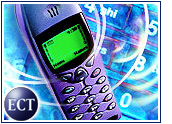
Few segments of e-commerce have been more over-hyped, and more disappointing, than mobile commerce.
According to Jupiter Media Metrix, the U.S. has the largest base of mobile phone users of any country in the world, 110 million. Yet less than 0.1 percent of those users bought goods using wireless data services in 2000, and merely 7 percent of wireless device owners said they would try mobile shopping this year.
What is going on?
“The main problem is it’s not a very compelling proposition for the consumer,” Yankee Group mobile analyst Adam Zawel told the E-Commerce Times. “There needs to be a reason to make a purchase using your wireless device. No one’s going to bother with an inferior experience on wireless when they can do it on their home PC.”
According to Dylan Brooks of Jupiter Media Metrix, it would be a mistake to start placing the blame for the failures of m-commerce on poor user interfaces and slow networks.
Consumer Indifference
“There’s been a real effort to put the cart before the horse,” Brooks told the E-Commerce Times. “Of trying to get m-commerce before you get users to start with mobile content.”
In fact, a recent consumer survey taken by Jupiter Media Metrix of early wireless adopters revealed that only 2 percent of respondents had made even one wireless transaction.
The top reason why not? It was not something they needed. Lack of trust and the high costs of doing m-commerce also placed high on the why-not list.
However, both Zawel and Brooks stated that the future of m-commerce is not all doom and gloom. It is too early in the game for that.
“Just like with the Internet, when people become comfortable with the medium, they’ll start buying,” Brooks said. “The major impact of U.S. being behind the curve in mobile activity is that we’re later in that (buying) cycle. We’re still a few years away from surfing and data services in handsets.”
Content Out in Front
So what can consumers expect from their wireless phones in the near future?
“Digital content, such as ringtones and icons, represent the first opportunity,” Zawel said. “We’re already seeing the beginning of a premier content market.”
Jupiter Media Metrix predicted that content services such as item availability notifications, customer service text messaging, and promotional messages will influence US$85 billion in online and offline purchases over the next five years.
However, Brooks warned that “the folks providing the content don’t really have a business model to promote it.”
Getting Physical
Zawel said that years from now, there will be opportunities for using your phone to interact with anything you come across in the physical world — to buy a Coke from a vending machine, for example.
“That involves a change to the physical infrastructure that’s outside of the mobile realm right now, which is why this is a long-term opportunity,” said Zawel. “Customers aren’t screaming for a new way to pay (for physical goods and services). It will happen more likely in the travel industry, which will adopt wireless before others.”
The technology will also gradually improve, according to Zawel.
“In the next six months we’ll inch forward,” Zawel said. “There probably won’t be any real shattering developments, but we’ll more clearly see the light at the end of tunnel, with more announcements about faster networks and fancier devices such as Java phones.”
Consumers can expect download times five to 10 times faster next year, with speeds rising from 10 KB per second to 50 KB per second, Zawel said. And many next generation devices will be offered cheaply because they use less resources on carrier networks.
Doing the U.S. Rag
In the meantime, companies will have to start addressing the consumer perceptions of m-commerce that have placed the U.S. so far behind Europe and Japan.
“They can address the perception that it’s too costly to shop by your mobile device,” Brooks said. “There’s the opportunity to set up toll-free channels so that every time you fire up your wireless device, you don’t get a warning about being charged for Web access.”
However, companies with global scope, such as Amazon.com (Nasdaq: AMZN), may wish to forget about the U.S. mobile market for awhile and focus their m-commerce activities on opportunities overseas. Amazon has already begun shifting the majority of its wireless resources to places like Japan, Brooks said.
“One of the popular misnomers about Japan is they have higher speed wireless networks than the U.S.,” Brooks said. “In actuality, most are slower than any of the networks here. It’s more about crafting the services and getting the content providers.”
























































I AM a IT manager.
I would like to say that m-commerce can be success in U.S.
m-commerce need a well secure moudel to pertect consumer from being cheated.
Both in-store and web-based shopping allow browsing through alternatives, and permit a salesperson or a reviewer to comment on the product (e.g. Amazon’s reviews). M-commerce at this point doesn’t because of the difficulty of presenting in-depth content. M should be well-suited for buyers who know exactly what they want or who are buying under time constraints (e.g. tracking the bids on Ebay).
Whatever happened to m-commerce reminds me of what happened to e-commerce. When e-commerce tries to enter mainstream commerce, it competes with offline stores. In an environment where offline stores are abundant and convenient, e-commerce will have hard time.
Our company, http://www.eguo.com, did a study in an affluent community in Beijing with 10,000 families. We opened a 24-hour store, offer catalogs, and web site to complement that store. If people order online or through phone, they get their orders delivered within 20 minutes. We basically provide three channels for consumers to choose: offline, phone, and web. Guess what is the result? I AM sure you know.
m-commerce faces competition from e-commerce. When computers are everywhere, from work to home, why people bother to buy through M? It is not going to be a mainstream channel.
Paying for everyday occurances is typically done with cash or debit card or credit card. True m-commerce is the application of these common ubiquitous transactions via a mobile device… Mobile phone or PDA, not using a PC to buy a book on Amazon. Paying for coffee, tolls, parking meters, lunch and virtually any retail purchase you can accomplish with a card now will be accomplished via a mobile device with an electronic cash wallet and encrypted SMS credit or debit numbers. The key is accepting the fact that mobile devices can accomplish much, much more than the mag stripe bank card in your wallet.
The banking sector has for too long been constricting the development of M-comm by not certifying personal mobile devices to execute transactions accross their networks or POS devices. The Banks have been using 1960s magstripe technology in a very profitable manner …Why change and have to spend to upgrade to the 21st century? http://www.tvac.net/philosophy.htm